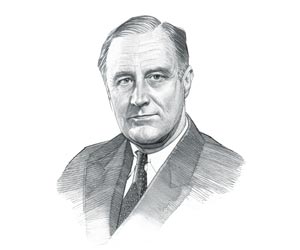|
|
|
|
|
President Roosevelt appointed Robert Fechner, a national labor union leader, as the Director of the Civilian Conservation Corps (CCC). The aims of the CCC was to find immediate conservation work in the nation's forests, parks and rangelands for hundreds of thousands of unemployed, unskilled young men aged 18 to 25 years old, and provide training for those who enrolled in the project. Work included the planting of trees, building reservoirs, recreational facilities, forest trail construction, disaster relief and fire control projects. What did the Civilian Conservation Corps do? The Civilian Conservation Corps (CCC) was a public work relief program that employed young men to contribute to the conservation of the nationís natural resources. Those selected for the CCC lived in camps and were provided with room, board, clothing, medical care, transportation and the opportunity to attend an education program. What was the purpose of the Civilian Conservation Corps? The purpose of the Civilian Conservation Corps was to relieve wide-spread youth unemployment, restore the nation's natural resources and provide educational facilities Was the Civilian Conservation Corps a success? Yes, the CCC became one of the most successful of New Deal back-to-work programs and led to impressive conservation achievements. Over three billion trees were planted, 97,000 miles of forest trails and roads were built, rivers and lakes were stocked with nearly a billion fish, 3,470 fire towers were erected and the wildlife population increased Facts about
Civilian Conservation Corps The 1933 Emergency Conservation Work (ECW) Act legislation provided for the creation of a government agency, the CCC, that would put unskilled, unemployed young people to work developing conservation infrastructure on lands owned by the federal and state governments Civilian Conservation Corps (CCC) was a public work relief program that operated from 1933 to 1942 as part of FDR's New Deal initiatives In 1933 the nation was in the grip of the Great Depression with about one third of the workforce unemployed. Young people were particularly susceptible to the economic crisis with many finding themselves unskilled, untrained, unable to obtain work experience, and lacking an adequate education. They watched their families falling into deep poverty and, being unable to help, felt a burden to their families. The Civilian Conservation Corps (CCC) provided the opportunity to leave home and earn a small wage in a safe, healthy, outdoor environment. CCC Posters encouraged participation in the scheme as "A young man's opportunity for work, play, study and health". Those working for the CCC were paid a dollar a day, with $25.00 per month sent home to their dependents, alleviating poverty at home. The creation of the Civilian Conservation Corps (CCC) combined President Roosevelt's commitment to conservation and love of nature with his drive to help the unemployed. The idea for the Civilian Conservation Corps originated from FDRís experiences with the Conservation Movement of the Progressive Era and his involvement with the Boy Scouts Young men who were employed in the CCC were single, from a family on relief and had passed a medical examination. Enlistment into the CCC lasted six months with an option to re-enroll for additional 6 month periods for a maximum of two years. The CCC units were the same as Army Corps areas. The young men were first assigned to a CCC company, that consisted of 200 men, and reported to an Army post for their induction and swore a pledge of obedience. Military Officers were responsible for the men in non-working hours and under the direction of members of the National Forestry Service during the working hours from 5 p.m. until 8 a.m. Free time was spent participating in sports and recreations such as fishing and hunting or indoor games such as ping-pong. Young men also attended dances and other recreational activities in the local community. Army garrison rations were designated for feeding the CCC workers. The men were provided with three square meals a day of breakfast, lunch and dinner and ate the same food that was given to soldiers in the Army. Their rations were larger than soldiers as so many men were under nourished. Food included fresh fruits and vegetables, beef, pork, chicken, oatmeal, bacon, eggs, milk, bread, butter, coffee etc Each CCC worker was issued with clothing or uniforms consisting of two pairs of denim trousers, jumpers, shirts, belt, tie, shoes, socks, underwear, raincoat and winter clothing if necessary The first CCC camp was was named Camp Roosevelt and was located in the George Washington National Forest, near Luray, Virginia. Accommodation for the workers was initially set up in tents but as time passed prefabricated buildings were erected or permanent buildings were built 2.5 million men were employed by the CCC between 1933 and 1942 and there were about 2,650 camps operating in all US states and territories. CCC enrollees were performing more than 100 different kinds of work to restore the nation's natural resources. The different types of jobs included the planting of trees, constructing reservoirs, creating forest camping sites and recreational facilities, constructing forest trail and roads, fire control projects and disaster relief. Disaster relief work was undertaken in response to emergencies caused by floods, storms, hurricanes and forest fires Education was a volunteer activity undertaken during non-working hours. During the nine year history of the CCC than 40,000 illiterate young men were taught to read and write. The CCC became one of the most successful of New Deal back-to-work programs and led to impressive and inspiring conservation achievements. The Civilian Conservation Corps lasted until 1942 as the nation concentrated its efforts on war production and young men enlisted to fight in World War II |
| US American History |
| 1929-1945: Depression & WW2 |
|
|
|
|
|
First Published2016-04-19 | |||
|
Updated 2018-01-01 |
Publisher
Siteseen Limited
| ||
|
|

